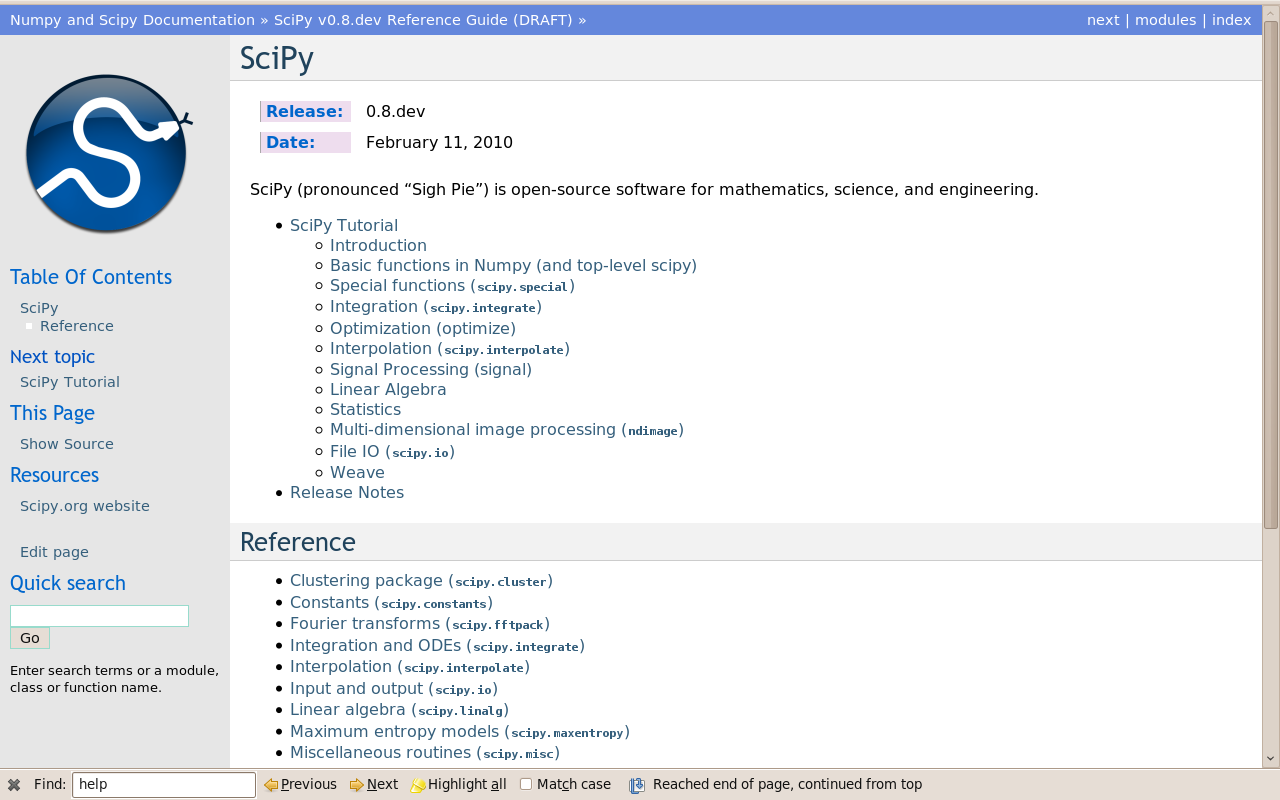1.6. Getting help and finding documentation¶
Author: Emmanuelle Gouillart
Rather than knowing all functions in Numpy and Scipy, it is important to find rapidly information throughout the documentation and the available help. Here are some ways to get information:
In Ipython,
help functionopens the docstring of the function. Only type the beginning of the function’s name and use tab completion to display the matching functions.In [204]: help np.v np.vander np.vdot np.version np.void0 np.vstack np.var np.vectorize np.void np.vsplit In [204]: help np.vander
In Ipython it is not possible to open a separated window for help and
documentation; however one can always open a second Ipython shell
just to display help and docstrings…

Numpy’s and Scipy’s documentations can be browsed online on http://docs.scipy.org/doc. The
searchbutton is quite useful inside the reference documentation of the two packages (http://docs.scipy.org/doc/numpy/reference/ and http://docs.scipy.org/doc/scipy/reference/).Tutorials on various topics as well as the complete API with all docstrings are found on this website.

Numpy’s and Scipy’s documentation is enriched and updated on a regular basis by users on a wiki http://docs.scipy.org/doc/numpy/. As a result, some docstrings are clearer or more detailed on the wiki, and you may want to read directly the documentation on the wiki instead of the official documentation website. Note that anyone can create an account on the wiki and write better documentation; this is an easy way to contribute to an open-source project and improve the tools you are using!
Scipy central http://central.scipy.org/ gives recipes on many common problems frequently encountered, such as fitting data points, solving ODE, etc.

Matplotlib’s website http://matplotlib.org/ features a very nice gallery with a large number of plots, each of them shows both the source code and the resulting plot. This is very useful for learning by example. More standard documentation is also available.
Finally, two more “technical” possibilities are useful as well:
In Ipython, the magical function
%psearchsearch for objects matching patterns. This is useful if, for example, one does not know the exact name of a function.In [3]: import numpy as np In [4]: %psearch np.diag* np.diag np.diagflat np.diagonal
numpy.lookfor looks for keywords inside the docstrings of specified modules.
In [45]: numpy.lookfor('convolution') Search results for 'convolution' -------------------------------- numpy.convolve Returns the discrete, linear convolution of two one-dimensional sequences. numpy.bartlett Return the Bartlett window. numpy.correlate Discrete, linear correlation of two 1-dimensional sequences. In [46]: numpy.lookfor('remove', module='os') Search results for 'remove' --------------------------- os.remove remove(path) os.removedirs removedirs(path) os.rmdir rmdir(path) os.unlink unlink(path) os.walk Directory tree generator.
If everything listed above fails (and Google doesn’t have the answer)… don’t despair! Write to the mailing-list suited to your problem: you should have a quick answer if you describe your problem well. Experts on scientific python often give very enlightening explanations on the mailing-list.
- Numpy discussion (numpy-discussion@scipy.org): all about numpy arrays, manipulating them, indexation questions, etc.
- SciPy Users List (scipy-user@scipy.org): scientific computing with Python, high-level data processing, in particular with the scipy package.
- matplotlib-users@lists.sourceforge.net for plotting with matplotlib.
